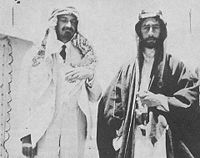Difference between revisions of "Chaim Weizmann" - New World Encyclopedia
(import, category, credit) |
(claimed) |
||
| Line 1: | Line 1: | ||
| + | {{Claimed}} | ||
{{Infobox_President | name =Haim Azriel Weizman | {{Infobox_President | name =Haim Azriel Weizman | ||
| nationality =Israel | | nationality =Israel | ||
Revision as of 04:51, 27 May 2007
| [[Image:{{{image name}}}|225px|center|Haim Azriel Weizman]] | |
| Term of office | {{{date1}}} – {{{date2}}} |
| Preceded by | {{{preceded}}} |
| Succeeded by | {{{succeeded}}} |
| Date of birth | {{{date of birth}}} |
| Place of birth | {{{place of birth}}} |
| Date of death | {{{date of death}}} |
| Place of death | {{{place of death}}} |
| Spouse | {{{wife}}} |
| Political party | |
Haim Azriel Weizman (Hebrew: חיים עזריאל ויצמן, also known as Chaijim Weizmann or Chaim Weizmann, November 27, 1874 – November 9, 1952) was a chemist, statesman, President of the World Zionist Organization, first President of Israel (elected February 1, 1949, served 1949 - 1952) and founder of a research institute in Israel that eventually became the Weizmann Institute of Science.
Weizman was born in the small village of Motol (Motyli, now Motal') near Pinsk (Russian Empire, now in Belarus) and graduated in chemistry from the University of Fribourg in Switzerland in 1899. He lectured in chemistry at the University of Geneva (1901-3) and later taught at the University of Manchester.
He became a British subject in 1910, and in World War I he was (1916-19) director of the British Admiralty laboratories. He became famous because he discovered how to use bacterial fermentation to produce large quantities of desired substances and is nowadays considered to be the father of industrial fermentation. He used the bacterium Clostridium acetobutylicum (the Weizman organism) to produce acetone. Acetone was used in the manufacture of cordite explosive propellants critical to the Allied war effort (see Royal Navy Cordite Factory, Holton Heath). Weizman transferred the rights to the manufacture of acetone to Commercial Solvents Corporation in exchange for royalties.
In 1917, he worked with Lord Balfour on the Balfour Declaration. A founder of so-called synthetic Zionism, Weizman supported grass-roots colonization efforts as well as higher-level diplomatic activity. Siding with neither Labour Zionism on the left nor Revisionist Zionism on the right, Weizman was generally associated with the centrist General Zionists.
On January 3, 1919, he and the future King Faisal I of Iraq signed the Faisal Weizman Agreement establishing relations between Arabs and Jews in the Middle East. After 1920, he assumed leadership in the world Zionist movement, serving twice (1920-31, 1935-46) as president of the World Zionist Organization. In 1921, Weizman went along with Albert Einstein for a fund-raiser to establish a Hebrew University in Jerusalem.
In 1936 he addressed the Peel Commission, set up by Stanley Baldwin, whose job it was to consider the working of the British Mandate of Palestine. He remained convinced that the Commission offered new hope to the Zionist movement.
During World War II, he was an honorary adviser to the British Ministry of Supply and did research on synthetic rubber and high-octane gasoline. (Formerly Allied-controlled sources of rubber were largely inaccessible owing to Japanese occupation during World War II, giving rise to heightened interest in such innovations.)
He met with United States President Harry Truman and worked to obtain the support of the United States for the establishment of the State of Israel. Weizman became the first President of Israel in 1949. At Rehovot, where he lived, Weizman founded a research institute (now the Weizmann Institute of Science). He wrote many papers for scientific journals. His nephew Ezer Weizman also became president of Israel.
| ||||||||||
Chaim Weizman AZA
The international jewish youthgroup known as the Aleph Zadik Aleph have two chapters named after Chaim Weizman, Chaim Weizman AZA #360 (also known as CWAZA) in Portland, Oregon and Chaim Weizmann AZA #1510 (aslo known as CW1510) in Omaha, Nebraska.
See also
- Maria Weizman
External links
- Biography at the Jewish Agency site
- Biographical notes at the Israel Ministry of Foreign Affairs
- Weizman Institute of Science Website
- Webpage on Haim Weizman's laboratory at the Weizman Institute (includes info and links on Weizman's scientific work)
| Preceded by: David Ben-Gurion |
Chairmen of the Provisional State Council May 17, 1948 - February 17, 1949 |
Succeeded by: ceased to exist |
| Preceded by: new title |
President of Israel February 1, 1949 - 9 November 1952 |
Succeeded by: Yitzhak Ben-Zvi |
Credits
New World Encyclopedia writers and editors rewrote and completed the Wikipedia article in accordance with New World Encyclopedia standards. This article abides by terms of the Creative Commons CC-by-sa 3.0 License (CC-by-sa), which may be used and disseminated with proper attribution. Credit is due under the terms of this license that can reference both the New World Encyclopedia contributors and the selfless volunteer contributors of the Wikimedia Foundation. To cite this article click here for a list of acceptable citing formats.The history of earlier contributions by wikipedians is accessible to researchers here:
The history of this article since it was imported to New World Encyclopedia:
Note: Some restrictions may apply to use of individual images which are separately licensed.

